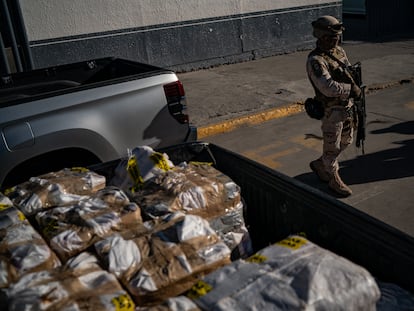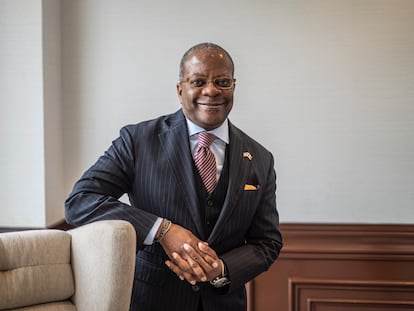Fentanyl experiments, crypto payments and feeding people to tigers: A look inside the criminal empire of El Chapo’s sons
The heirs of Joaquín ‘El Chapo’ Guzmán have transformed the Sinaloa Cartel. According to the Department of Justice, the drug lord’s children have overseen a massive increase in fentanyl being trafficking from Mexico into the United States
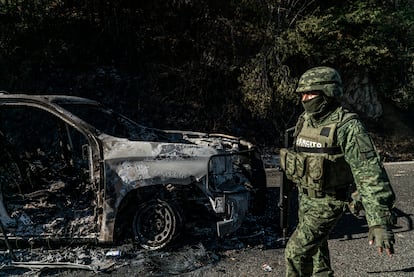
The Sinaloa Cartel has entrusted its future to a second generation. Three of Joaquín “El Chapo” Guzmán’s sons have taken the reins of the drug trafficking business in Mexico. They are now building up an efficient corporate structure, perfecting the model that was founded by their father 30 years ago.
This past week, the U.S. Department of Justice indicted three of El Chapo’s sons — Iván Archivaldo, Jesús Alfredo Guzmán Salazar and Ovidio Guzmán López — for allegedly trafficking fentanyl from Mexico into the United States. The American government is looking to lay six charges against them and another 25 members of the powerful criminal organization. The authorities explain that Los Chapitos — as the sons of the feared capo are known — have restructured the Sinaloa Cartel in a highly-organized fashion, while also becoming the largest suppliers of fentanyl in North America.
These activities began in 2014. That year, Ovidio Guzmán López — known as “the mouse” — founded his first laboratory to process fentanyl in Culiacán, in the Mexican state of Sinaloa. The youngest of the Guzmán brothers took advantage of the routes established by his father’s cartel to send small shipments to Tijuana and pass the drugs through the usual channels — land, sea and air — to reach Los Angeles.
By 2016, it was clear that the business had to make a change. After its beginnings in the 1980s with marijuana trafficking, the organization eventually grew to include cocaine, heroin and methamphetamine. The group founded by El Chapo — alongside Ismael El Mayo Zambada — would certainly go through other transformations, but none like the latest, according to U.S. authorities: “The cartel has grown exponentially in volume, scale and sophistication.”
In 2016, in the state of Durango, Los Chapitos converted a laboratory — originally dedicated to manufacturing methamphetamine — into a new facility to produce fentanyl. Since then, they haven’t stopped expanding operations.
El Chapo was captured in 2016 and extradited to the United States in 2017. At that point, his three sons personally took the reins of the family business and refocused it on trafficking fentanyl. Ovidio was in charge of setting up a network of laboratories to ensure sustained production, while Jesús Alfredo built alliances to purchase the necessary chemicals from China to “cook” the fentanyl. Meanwhile, Iván Archivaldo — the eldest of the sons — managed the security apparatus around the entire operation, protecting laboratories and distribution routes with highly-armed men.
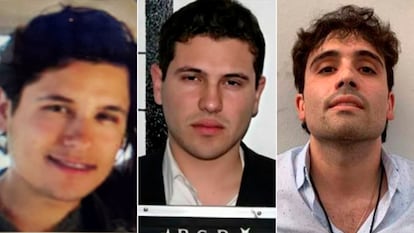
The sons also undertook a kind of cleansing in the states of Coahuila, Michoacán, Sonora, Tamaulipas and Chihuahua, ensuring they had control of strategic positions. They sowed terror among their enemies. However, they also formed new alliances, such as in Coahuila with the Northeast cartel, or in Chihuahua, with the Artistas Asesinos street gang.
Cruelty continues to be the hallmark of the clan, according to the U.S. Department of Justice. Los Chapitos have allied with the Ninis — a group of hitmen from Sinaloa — and turned them into their armed wing. Torture is also commonly used to punish those who don’t comply with their wishes. The techniques include waterboarding, electrocution, beatings and even throwing people to tigers, according to the DOJ. According to the American authorities, on Iván Archivaldo’s ranch in Sinaloa, the drug traffickers keep an unspecified number of tigers as pets. They occasionally feed them the bodies of their enemies, dead or alive.
One of the pillars of the operation is obtaining the chemicals that are used to make fentanyl. “To manufacture fentanyl, the cartel uses precursor chemicals procured principally from China,” the DOJ stated in is April 14 press release. The cartel bosses have been weaving extensive networks, which involve sending chemicals from Asia past Mexican customs. Guatemalan national Ana Gabriela Rubio Zea is in charge of this operation. She has partnered with the Chinese firm Wuhan Shookang Biological Technology, which obtains the chemical elements. To mislead the Mexican authorities, they are passed off as food containers or packaged alongside legal products. Some shipments arrive at the ports in vessels that have previously passed through countries such as the U.S. and Germany, since they are subject to less strict controls than those that arrive directly from China.
The chemicals are subsequently distributed to the laboratories that are mainly located in the state of Sinaloa. There, the cartel prepares fentanyl to be sent north, in the form of pills or powder. The Justice Department says that, in the last year, the Mexican government has seized an underground laboratory that had elevators to move the shipments, as well as industrial stoves and pill presses.
“The cartel is trying to produce the most powerful fentanyl and sell it in the U.S. at the lowest price,” the U.S. government notes. The testimonies of undercover DEA agents reveal that, in the laboratories, the foremen experiment on humans with different doses of fentanyl and observe how the drug reacts with others, such as heroin. The Attorney General’s office recounts the case of a woman who was given three doses of the opiate to calculate the chemical amounts, before she ultimately died of an overdose. Some addicts have also been subjected to these tests. One of them died of an overdose, but the drug they consumed was still sent to the United States.
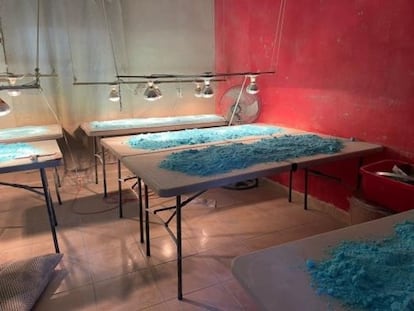
El Chapo’s sons use the old-fashioned ways of the Sinaloa Cartel to bring fentanyl into the U.S.: in planes, trucks, boats, as well as through border checkpoints and the group’s infamous tunnels. Because the volume of the opiate is less than that of other substances, the drug lords have increased traffic through land crossings between Mexico and the United States, hidden in cars, or in people — so-called “mules” — who cross the checkpoints daily.
“The [Sinaloa] cartel relies on the impossibility of inspecting all items that cross the border… [they] also exploit corruption on both sides of the border,” say U.S. authorities. Special attention is paid, for instance, to the crossing between Ciudad Juárez and El Paso, Texas. There, the U.S. government discovered that one of its immigration officials was being paid by the cartel and allowing mules to pass the checkpoint without inspection. For 12 months, the officer — who covered a night shift — let women through, who were each carrying up to 2,000 pills on each trip. They would sometimes cross up to three times in a single night. The pills were even imprinted with the word Ratón — Spanish for “mouse,” Ovidio’s nickname.
The business has been more than profitable: with one kilogram of rough chemicals — for which they pay $800 — they can manufacture up to 415,000 pills, or four kilograms of fentanyl powder. The pills are sold individually in places like New York for up to $3. Each shipment represents millions of dollars that are sent to Mexico through account transfers via tax havens and cryptocurrencies. Drug dealers in the U.S. are in charge of collecting the money and depositing it into the cartel’s bitcoin accounts, which are managed from Mexico.
Cryptocurrency technology makes it difficult for financial systems from detecting the money. It can then be converted to dollars or pesos in Mexico. In some cases, conversion to legal tender isn’t even necessary: some suppliers in China accept payment in cryptocurrencies. The organization also buys real estate in the United States, makes shipments of cash, or buys products in the U.S. — such as cellphones — which are then sold in Mexico to launder the drug money.
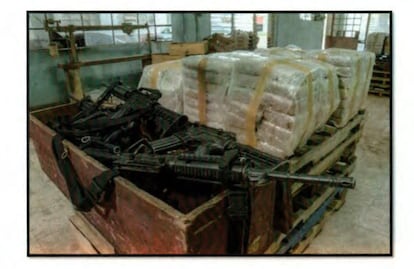
Drug Enforcement Administration Administrator Anne Milgram described the Sinaloa Cartel as being “more ruthless, more violent, more deadly” than in the best years of El Chapo Guzmán. The warning focuses on the exponential growth of fentanyl trafficking and the serious damage it has already caused in the U.S. Between August 2021 and 2022, more than 107,000 Americans died from an opioid overdose. Narcotics experts say the drug is 50 times more potent than heroin. The structure set up by El Chapo’s heirs reinforces the argument that Mexico, the United States and China are fighting against a new model of illegal drug trafficking. The second generation of the Sinaloa Cartel has a global reach — with a presence in around 45 countries — innovative tools and a transnational vision… something that, even in his best days, El Chapo Guzmán couldn’t have imagined.
Sign up for our weekly newsletter to get more English-language news coverage from EL PAÍS USA Edition
Tu suscripción se está usando en otro dispositivo
¿Quieres añadir otro usuario a tu suscripción?
Si continúas leyendo en este dispositivo, no se podrá leer en el otro.
FlechaTu suscripción se está usando en otro dispositivo y solo puedes acceder a EL PAÍS desde un dispositivo a la vez.
Si quieres compartir tu cuenta, cambia tu suscripción a la modalidad Premium, así podrás añadir otro usuario. Cada uno accederá con su propia cuenta de email, lo que os permitirá personalizar vuestra experiencia en EL PAÍS.
¿Tienes una suscripción de empresa? Accede aquí para contratar más cuentas.
En el caso de no saber quién está usando tu cuenta, te recomendamos cambiar tu contraseña aquí.
Si decides continuar compartiendo tu cuenta, este mensaje se mostrará en tu dispositivo y en el de la otra persona que está usando tu cuenta de forma indefinida, afectando a tu experiencia de lectura. Puedes consultar aquí los términos y condiciones de la suscripción digital.
More information
Archived In
Últimas noticias
Christmas loses its festive spirit: ICE fears cast shadow over religious celebrations
All the effects of gentrification in one corner of Mexico’s Colonia Roma
Palestinian reporter Youmna El Sayed: ‘My family told me I had to choose between being a journalist or a mother’
Russell Tovey: ‘I was advised many times not to come out, I don’t think there was many people who’d done that — and I feel really proud that I’m one of those that did’
Most viewed
- Families demand repatriation of bodies of Colombians who died in Ukraine: ‘This war is a slaughterhouse for foreigners’
- The low-cost creative revolution: How technology is making art accessible to everyone
- Liset Menéndez de la Prida, neuroscientist: ‘It’s not normal to constantly seek pleasure; it’s important to be bored, to be calm’
- Christian Louboutin: ‘Young people don’t want to be like their parents. And if their parents wear sneakers, they’re going to look for something else’
- ‘El Limones’ and the growing union disguise of Mexican organized crime

